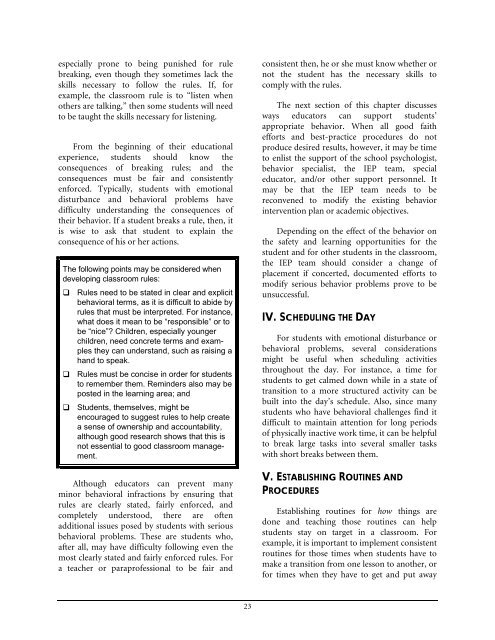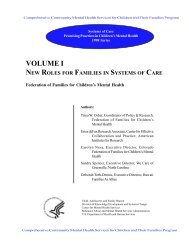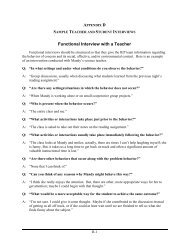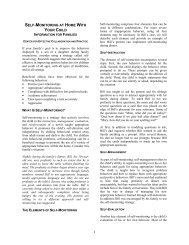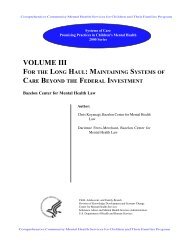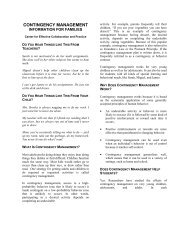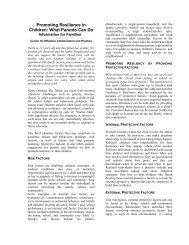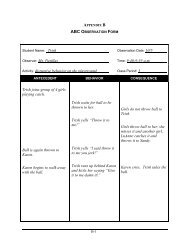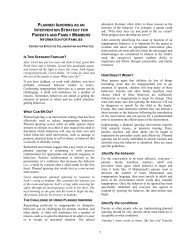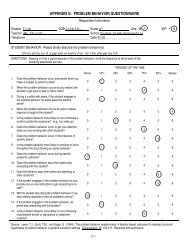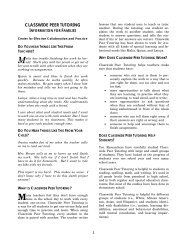educational strategies for children with emotional and behavioral ...
educational strategies for children with emotional and behavioral ...
educational strategies for children with emotional and behavioral ...
Create successful ePaper yourself
Turn your PDF publications into a flip-book with our unique Google optimized e-Paper software.
especially prone to being punished <strong>for</strong> rule<br />
breaking, even though they sometimes lack the<br />
skills necessary to follow the rules. If, <strong>for</strong><br />
example, the classroom rule is to “listen when<br />
others are talking,” then some students will need<br />
to be taught the skills necessary <strong>for</strong> listening.<br />
From the beginning of their <strong>educational</strong><br />
experience, students should know the<br />
consequences of breaking rules; <strong>and</strong> the<br />
consequences must be fair <strong>and</strong> consistently<br />
en<strong>for</strong>ced. Typically, students <strong>with</strong> <strong>emotional</strong><br />
disturbance <strong>and</strong> <strong>behavioral</strong> problems have<br />
difficulty underst<strong>and</strong>ing the consequences of<br />
their behavior. If a student breaks a rule, then, it<br />
is wise to ask that student to explain the<br />
consequence of his or her actions.<br />
The following points may be considered when<br />
developing classroom rules:<br />
Rules need to be stated in clear <strong>and</strong> explicit<br />
<strong>behavioral</strong> terms, as it is difficult to abide by<br />
rules that must be interpreted. For instance,<br />
what does it mean to be “responsible” or to<br />
be “nice”? Children, especially younger<br />
<strong>children</strong>, need concrete terms <strong>and</strong> examples<br />
they can underst<strong>and</strong>, such as raising a<br />
h<strong>and</strong> to speak.<br />
Rules must be concise in order <strong>for</strong> students<br />
to remember them. Reminders also may be<br />
posted in the learning area; <strong>and</strong><br />
Students, themselves, might be<br />
encouraged to suggest rules to help create<br />
a sense of ownership <strong>and</strong> accountability,<br />
although good research shows that this is<br />
not essential to good classroom management.<br />
Although educators can prevent many<br />
minor <strong>behavioral</strong> infractions by ensuring that<br />
rules are clearly stated, fairly en<strong>for</strong>ced, <strong>and</strong><br />
completely understood, there are often<br />
additional issues posed by students <strong>with</strong> serious<br />
<strong>behavioral</strong> problems. These are students who,<br />
after all, may have difficulty following even the<br />
most clearly stated <strong>and</strong> fairly en<strong>for</strong>ced rules. For<br />
a teacher or paraprofessional to be fair <strong>and</strong><br />
23<br />
consistent then, he or she must know whether or<br />
not the student has the necessary skills to<br />
comply <strong>with</strong> the rules.<br />
The next section of this chapter discusses<br />
ways educators can support students’<br />
appropriate behavior. When all good faith<br />
ef<strong>for</strong>ts <strong>and</strong> best-practice procedures do not<br />
produce desired results, however, it may be time<br />
to enlist the support of the school psychologist,<br />
behavior specialist, the IEP team, special<br />
educator, <strong>and</strong>/or other support personnel. It<br />
may be that the IEP team needs to be<br />
reconvened to modify the existing behavior<br />
intervention plan or academic objectives.<br />
Depending on the effect of the behavior on<br />
the safety <strong>and</strong> learning opportunities <strong>for</strong> the<br />
student <strong>and</strong> <strong>for</strong> other students in the classroom,<br />
the IEP team should consider a change of<br />
placement if concerted, documented ef<strong>for</strong>ts to<br />
modify serious behavior problems prove to be<br />
unsuccessful.<br />
IV. SCHEDULING THE DAY<br />
For students <strong>with</strong> <strong>emotional</strong> disturbance or<br />
<strong>behavioral</strong> problems, several considerations<br />
might be useful when scheduling activities<br />
throughout the day. For instance, a time <strong>for</strong><br />
students to get calmed down while in a state of<br />
transition to a more structured activity can be<br />
built into the day’s schedule. Also, since many<br />
students who have <strong>behavioral</strong> challenges find it<br />
difficult to maintain attention <strong>for</strong> long periods<br />
of physically inactive work time, it can be helpful<br />
to break large tasks into several smaller tasks<br />
<strong>with</strong> short breaks between them.<br />
V. ESTABLISHING ROUTINES AND<br />
PROCEDURES<br />
Establishing routines <strong>for</strong> how things are<br />
done <strong>and</strong> teaching those routines can help<br />
students stay on target in a classroom. For<br />
example, it is important to implement consistent<br />
routines <strong>for</strong> those times when students have to<br />
make a transition from one lesson to another, or<br />
<strong>for</strong> times when they have to get <strong>and</strong> put away


